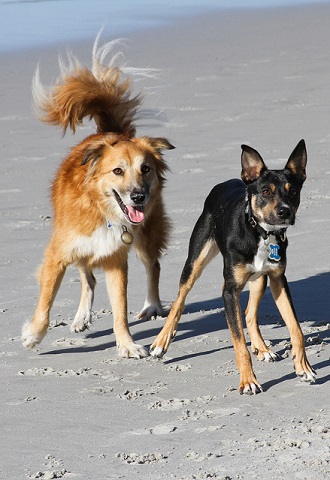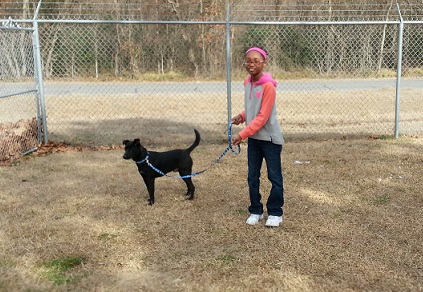Dog lovers have so many options available when they’re ready to adopt a dog. Just one of those options is to go to a shelter.
The reason I used “kill shelter” in the title is because I want to focus on how to choose a dog from a crowded shelter where there is urgency to save a life but often little info about each dog.
This is often the case at shelters that kill dogs for space, but not always. I’m generalizing.
If any of you have adopted a dog from a shelter, I hope you’ll share some advice in the comments on how you made your decision and what you might do differently the next time.
Many dog lovers are really drawn to saving a dog’s life, but it would be helpful to get some advice from those who’ve been there.
Choosing the right shelter dog
The following are some of my own ideas as well as some examples from others.
Get to the shelter early.
If you get to the shelter earlier in the day, you’ll have more time to look at the dogs as well as time to step away and think about your decision before the shelter closes.
“If you have a dog-obsessed friend, ask them to accompany you to the shelter and observe the dogs with you,” said Jen deHaan, who maintains the blog DogThusiast. “They will be a terrific resource to bounce ideas off of.”
deHaan adopted her dog Mort from a kill shelter (he’s pictured above), and she also volunteered at a kill shelter in the past.
Consider older dogs.
 Consider an older dog that is at least 5 years old. I’m generalizing again, but middle-aged dogs and senior dogs are more likely to be potty trained and less likely to have major behavioral problems.
Consider an older dog that is at least 5 years old. I’m generalizing again, but middle-aged dogs and senior dogs are more likely to be potty trained and less likely to have major behavioral problems.
I’m not talking about pulling on the leash or not knowing the “sit” command. I’m talking about severe aggression, severe separation anxiety, possessiveness, etc. The reality is, if there was a problem with the dog, someone would’ve likely surrendered her years ago. Oh, and older dogs are generally less energy, too.
Focus on behavior, not breed.
deHaan stressed that adopters should treat each dog as an individual. Instead of focusing on the dog’s appearance, age, gender, size or breed they should consider the dog’s personality, energy and temperament.
“While there certainly are breed and age tendencies, they are just that – tendencies,” she said. “For example, the 14-month-old English shepherd I adopted should have been high energy if I went by her breed and age standards, but she was a couch potato!”
[quote_center]”While there certainly are breed and age tendencies, they are just that – tendencies.”[/quote_center]
Does the dog focus on you?
“One of the first things I look for in a dog is how focused he or she is with me,” deHaan said. “Does the dog pay attention to people, or other dogs, or nothing in particular? Does the dog have an attention span? Does this puppy want to interact?”
She said to spend as much time as you can with the dog in the least stressful area as possible. So, maybe a quiet, isolated room. Or, see if you are allowed to go for a walk with the dog and a volunteer to see how the dog acts in a more natural environment.
Another tip deHaan suggested is to bring some toys along to see how toy motivated the dog is.
All of this combined information will help you determine how easy the dog might be to bond with and train, she said.
Does the dog seem to have experience living with a family?
There are some things you can try at the shelter to determine if the dog might have lived with a family, and therefore has some experience in a household, deHaan said.
For example, she suggested trying common interactions with the dog such as sit or down and also to see how well the dog walks on a leash. What does he do if the leash gets caught under his leg?
Another idea she had is to toss treats in the air to see if the dog can catch them.
The dog is stressed and may act differently once out of the shelter.
 “The most important thing to remember is that a shelter environment is very stressful, and a stressed dog is not behaving how they will when they are relaxed,” deHaan said. “So take all of the behavior with a grain of salt, and look at the big picture: attentiveness, drive, and the overall level of stress.”
“The most important thing to remember is that a shelter environment is very stressful, and a stressed dog is not behaving how they will when they are relaxed,” deHaan said. “So take all of the behavior with a grain of salt, and look at the big picture: attentiveness, drive, and the overall level of stress.”
She said some dogs might not come out of their “shell” until after they have lived in a home.
“Two of my three dogs blossomed after they came home,” she said. “But they were stressed while in the shelter, and their personalities weren’t too evident there.”
She also said she wouldn’t count on a presumed “low energy” dog to remain that way once out of the shelter. The dog could very well be a “handful” later on.
However, she did say a very relaxed dog in a stressful environment is “probably quite balanced in general.”
Some questions to ask the staff/volunteers:
Since deHaan used to volunteer at a kill shelter, I asked her for ideas on the types of questions adopters should ask the staff members or volunteers.
Here were her ideas:
[check_list]
- Has the dog been seen by an experienced behaviorist for an assessment? Can I read any details from it? (Also remember these assessments are sometimes performed in a stressed state and do not always give a fair evaluation of the dog. It’s just one thing to consider.)
- Do any volunteers have a lot of experience with this dog? Can I speak with him or her at some point? (At many shelters, this won’t be possible for many or most dogs, so in these cases, pick the volunteer’s brain for thoughts about the dog’s temperament.)
- How does the dog behave on the leash when walking by the other kennels?
- How does the dog act when someone comes to remove her from the kennel? Is she happy to see volunteers, or cautious?
- Does this dog normally bark at people from her kennel?
[/check_list]
Some additional questions I thought of:
[check_list]
- Have you ever seen this dog growl over her food? Have you ever seen her growl or show aggression in any situation?
- Does she keep her cage/kennel area clean? (If not, ask how often the dogs are taken out.)
- How long has she been here? Has her behavior changed during that time?
- Was she a stray or did her owners drop her off?
- Has she ever been around cats? Small dogs? Kids?
[/check_list]
Understand that in some shelters, the staff or volunteers will not be able to answer all or even any of these questions. The information might not be known.
Try to have the dog meet your other dogs if you have them.
“Do try to have the dogs meet before making a final decision,” deHaan said.
If you don’t know a lot about dog behavior, she suggested having at least one very experienced dog person observe the interaction.
“Choose a second dog who your dog is relaxed around,” she said. “They don’t have to play or be friends, but should at least be relaxed.”
Take a step back.
Once you’re close to making your decision, take at least an hour to step away and think on it. Go to lunch or grab some coffee with your spouse or friend. Talk it over. If you’re still not sure, take a day or a week to think on it some more.
I realize there is urgency to rescue a dog, especially after you’ve met the dog, but the reality is there are always more dogs to adopt. You owe it to yourself to do your best to choose the right one.
Embrace the challenge.

One of my blog readers, Jennifer Jenkins, said she and her family went to the shelter one Saturday just to “visit.” (I think you know where this is going!)
[quote_right]”We may not get the dog we want but we get the dog we need.”[/quote_right]They of course decided they would adopt a dog, and after a couple of their first choices didn’t work out, they ended up adopting a “long timer” named Huck, who they re-named Storm.
Storm was not what they family expected.
“He is hyper, hyper and hyper!” Jenkins said.
However, she said Storm has turned her family into more responsible dog owners, as they take him for lots of walks vs. just running in the backyard. They also work on training and she is thinking of putting him into agility or possibly dock jumping.
“Cesar Millan has said something to the effect of ‘we may not get the dog we want but we get the dog we need,’” she said. “He is so right.”
Some tips for preparing a home for a new dog
I know a lot of problems can be avoided (no matter where you get your dog) if you prepare as much as possible in advance. So, here we go:

Get your most important supplies lined up.
Food, a bowl and a leash are important, obviously, but so is a crate/kennel. Have one ready. The size of the crate you’ll need depends on the size of the dog, but you probably have some idea on what size dog you’ll want.
Stock up on some jerky or liver treats for training and bonding with your dog. Buy a few Kong-type toys (aff link) and peanut butter to stuff them with. Think about buying a baby gate so you can block off areas temporarily.
Have a potty training plan ready.
There’s a chance the dog won’t be housebroken, even if the shelter says he is. Just assume your adopted dog won’t be potty trained, and have a plan in place. Can you make it home during your lunch break? Can you gate off a small area? Can your neighbor help you out temporarily? Can you afford a dog walker?
Plan how you’ll safely introduce your pets.
This is something that should be planned in advance. Don’t just hope for the best.
Put your cat in another room when you leave for the shelter.
If you plan to have your dog meet your new dog at the shelter, have a friend ready to help. It would also be wise to drive two vehicles or to put the dogs in crates in the car for safety reasons.
Once you get home, have a plan for taking the dogs for a walk right away so they can get to know each other in a safe, controlled manner. A walk side-by-side in a neutral area is the best way to introduce most dogs or to help two dogs bond.
Have a training and exercise plan in place.
If this dog turns out to be super high energy, how will you provide him with exercise? Can you get up an hour earlier each morning and start a running routine? Is your wife willing to commit an hour to exercise the dog again after work? Can you afford dog daycare?
And what about training? Is there a trainer in your area you trust if issues come up? Have you looked into group obedience classes for teaching the basics?
Take at least three full days off from work.
I highly suggest taking at least a Friday, Saturday and Sunday off from work so you have three days to help the dog adapt to your home. I realize this isn’t always possible. It’s just the ideal scenario. A full week off from work would be even better if you can swing it.
OK, what do the rest of you think?
What would you add to this discussion?
Sign up to receive additional content in my bi-weekly newsletter:




Anna
Sunday 18th of September 2016
I am thinking of adopting a 5 year old dog. I have already met her once, and at the beginning growled at me because she was very protected with her owner. I went for a walk with her using a leash and she behaved much better than what I what I was counting. And in spite her owner being terrified with the idea of her getting into my car for he said she would destroy it, she just laid down and wagged her tail. My concern is when she comes home in stead of having her "jailed to a kennel with a short chain, alone in a garage, (a reason why she isn't potty trained) she will spend her time, while I work , free in 18 square meters. Unfortunately, when she comes home it will be late so we won't be able to go out. I fear it might be confusing for her and I will only have the weekend. I hope all ends well...
Kellie O'Brien
Thursday 16th of October 2014
Lindsay,
I have a question for you. I have had dealings with a breeder in town who breeds "designer" dogs- malti-tzus, yorkipoos, & maltipoos. She sold a puppy to someone I know for $850 that is not even CKC registered. In addition, she has about 50 dogs on her property- a single family home. When one enters her house they are greeted by about 30 dogs. After overcoming the shock of so many little dogs in one place yapping nonstop, one notices they are urinating on the floor, marking the furniture, drapes, etc. & humping each other. It is rather unsettling.
Before I knew anything about buying a dog I bought a 6 month old puppy from this breeder. She seemed to be a castaway that nobody had purchased & it was obvious that the breeder had no affection for her. She looked a little inbred (excessively protruding underbite, strangely almond shaped eyes). Although she was fed quality food and was quite slender, she ended up at 3 years old weighing about 18 lbs., which is rather large for a malti-tzu, don't you think?
This dog had emotional problems as well. She had to take anti-anxiety medication in order to function. When I tried to wean her off of it she became aggressive. She was incredibly anxious, afraid of every new place & situation. She shook & panted uncontrollably in the car. She developed separation anxiety which lasted in some form throughout her life. Although I was able to decondition her for when I was gone for a few hours, when I had to be out of town overnight or if I took Louie, my schnoodle somewhere with me, she was petrified- pacing, panting and checking the window all night long - even when staying with my daughter who she knew well. When I was gone overnight, she was given two benadryl just to keep her somewhat calm.
She was not comfortable with people & wouldn't let us pick her up for months. Even then, she stiffened in my arms & could never relax. She loved other dogs, however- she was CRAZY about them even though she was 'selfish' - vying for toys or anything else she wanted. I think my schnoodle was bitten by her because when I try to play toys with him, he sort of backs off & bats at it cautiously. I believe these behaviors are the result of not being properly socialized & from being in a pack of dogs her first critical months of life. I'm sure she fought for everything. She had to.
At 3 years old she became very sick with stones in her bladder. Since they were the type that would most likely return, we opted out of the surgery and, instead, decided to euthanize her. It got to the point where we knew she was very sick both physically & emotionally and that option seemed to be the kindest one.
When I took her into the vet, I sat in the waiting room with her on my lap. She was unusually quiet and relaxed, even though the waiting area was full of other dogs. My request to my vet was to hold her & feel her relax. I'd never had that experience with her & it warmed & broke my heart at the same time. My husband & I cried literally for over a week. I still miss her terribly. We mourn not only her loss but the life she could have led had she been treated properly the first six months of her life. . She was a baby- a sweet, innocent puppy!!!!
I'm telling you about this because I vowed I would close this breeder down. I just don't know how to do it. She also runs a boarding business (no kennels!!!) and a grooming business. I have researched the federal, state & local laws & unfortunately, Florida's laws are even more lax than many others. I know there's got to be a way to stop this business from operating.
I've requested a complaint packet from the CKC & since some of her dogs are registered with the AKC I will file a complaint with them as well. I plan to talk with Bay County Animal Control about the number of dogs she has on her property. I don't know what else to do. I was wondering if you had any experience with this type of situation and what your advice would be. Feel free to post this email & ask your readers- I'd like all of the suggestions I can get!
Thank you!!!
-Kellie O'Brien
Lindsay Stordahl
Friday 24th of October 2014
Hi Kellie. What a sad story. I'm so sorry for your loss, and based off what you said that breeder's property sounds like a terrible place for dogs. I really do not have any experience with the process of reporting someone like this. I think your idea of reporting the number of dogs would be a start. If she is paying the proper licenses, she may not even be doing anything illegal, unfortunately. You'll have to keep me updated on what happens, and I will think about some ideas of what you could do.
Dawn
Saturday 11th of October 2014
There are so many things to think about! The only time I adopted from a high kill shelter was when I worked at one years ago. Working there, I had the inside scoop on them and got to know their individual personalities. The ones I ended up adopting were ones that were not getting adopted but had great personalities.
BTW, my favorite tip of yours is to take three days off when bringing in a new pet. I had that opportunity with both Maya and Pierson. With Maya, the adjustment was mostly for the sake of my other dog Sephi. She did not want a new family member so me being home helped her ease into the new puppy. Pierson did not start coming out of his shell until after a few days so having time off really helped him adjust.
Camille @ GoodPetParent
Wednesday 8th of October 2014
This is such a helpful post... I've already shared it with everyone I know! I think lots of people have great intentions when they visit the shelter, but may be unprepared for how to choose the best dog for them, and what to do once they bring their new addition home. Many of the tips you mentioned can also be applied to adopting shelter cats as well. Thanks for such a thoughtful, well-written article!
Rachel @ My Two Pitties
Saturday 4th of October 2014
Great tips! I'd love to adopt my next dog from a kill shelter. I love the idea of saving a life, especially one that may have been overlooked or taken at any moment.
People should think about all the factors of their lifestyle, dog knowledge level, capabilities, time, schedule and other family members/animals before adopting:)